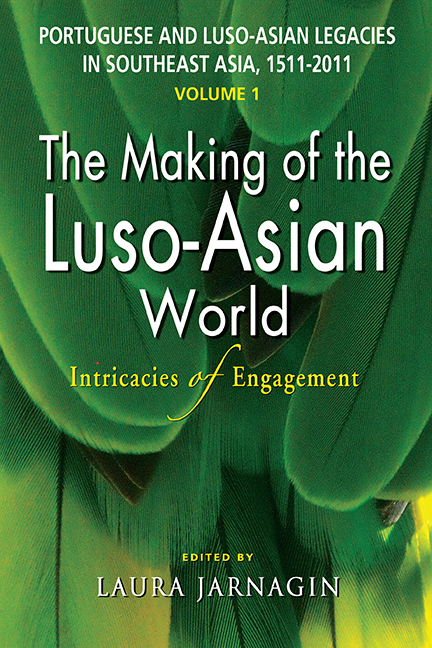 Portuguese and Luso-Asian Legacies in Southeast Asia, 1511–2011, vol. 1
Portuguese and Luso-Asian Legacies in Southeast Asia, 1511–2011, vol. 1 Book contents
- Frontmatter
- Contents
- List of Charts, Figures and Tables
- A Tribute to Glenn Ames
- Preface
- List of Contributors
- Glossary
- Introduction: Towards Clarity through Complexity
- Part One Adaptations and Transitions in the South and Southeast Asian Theatres, Sixteenth through Eighteenth Centuries
- Part Two Dispersion, Mobility and Demography from the Sixteenth into the Twenty-first Centuries
- Part Three Mixed Legacies: The Portuguese and Luso-Asians in the Twentieth and Twenty-first Centuries
- Bibliography
- Index
Introduction: Towards Clarity through Complexity
Published online by Cambridge University Press: 21 October 2015
- Frontmatter
- Contents
- List of Charts, Figures and Tables
- A Tribute to Glenn Ames
- Preface
- List of Contributors
- Glossary
- Introduction: Towards Clarity through Complexity
- Part One Adaptations and Transitions in the South and Southeast Asian Theatres, Sixteenth through Eighteenth Centuries
- Part Two Dispersion, Mobility and Demography from the Sixteenth into the Twenty-first Centuries
- Part Three Mixed Legacies: The Portuguese and Luso-Asians in the Twentieth and Twenty-first Centuries
- Bibliography
- Index
Summary
At the opening of the twenty-first century, statistical evidence indicates that European dominance of shipping and maritime traffic in Southeast Asia is now — slowly, glacially — coming to an end. This means that, for the first time in history, Westerners no longer account for majority ownership of the global maritime trade in and out of the region, a global seaborne commerce whose origins are five centuries old. The initiation of oceanic trade between the western extremities of the Eurasian landmass and its southeastern and eastern extremities (including insular and archipelagic appendages) dates to the early sixteenth century, and was first undertaken by the modest but scientifically advanced Western European state of Portugal and underwritten by capital from the Italian city-state of Genoa. On a grander scale, accessing Asia by sea in combination with the concurrent (re)discovery of the Western Hemisphere on the part of the Europeans changed the dynamic of humankind's interactions for all time and set in motion the makings of the globalized world we now know. Today, the Straits of Malacca, where the Portuguese arrived in 1511, continue to be the “shipping superhighway between the Indian and Pacific Oceans”.
From the very late fifteenth century until the mid-sixteenth century, the Portuguese installed themselves in strategic interstices throughout maritime Asia, especially at locations in the Indian Ocean and South China Sea, where an active seaborne trade linking southern Chinese, Southeast Asian and South Asian ports already existed. At the nexus of these two bodies of water, mingled in narrow straits, was the cosmopolitan emporium of Malacca, where Gujarati, Arab, Chinese and European merchants, among others, traded at this commercial hub. As one of Portugal's explorers in Asia, Tomé Pires, observed, “whoever is lord of Malacca has his hand on the throat of Venice”, Genoa's principal rival in the incipient capitalist economy then emerging in Western Europe.
In 1511, Afonso de Albuquerque established a commanding Portuguese presence at Malacca and thus “pierced the archipelago's chief commercial ganglion”, leaving this trading zone fragmented into more specialized components. Over time, the Portuguese “empire” or “network” (depending on whose nuanced academic terminology one prefers) became overextended and largely supplanted by other European interlopers in Asia: the Dutch, the French (to a lesser degree) and the English.
- Type
- Chapter
- Information
- Portuguese and Luso-Asian Legacies in Southeast Asia, 1511–2011, vol. 1The Making of the Luso-Asian World: Intricacies of Engagement, pp. 1 - 20Publisher: ISEAS–Yusof Ishak InstitutePrint publication year: 2011


